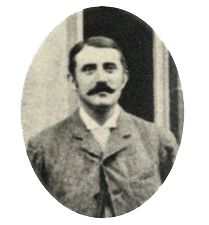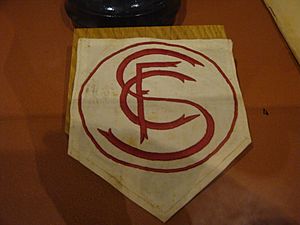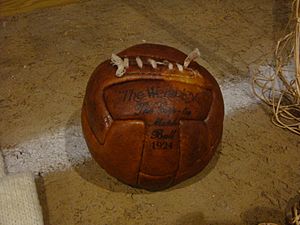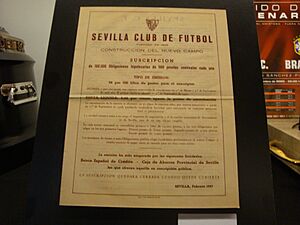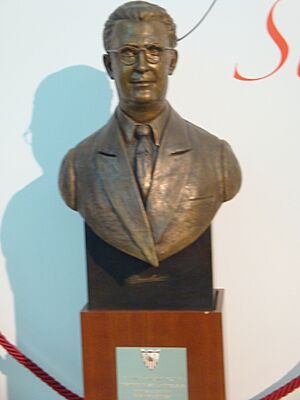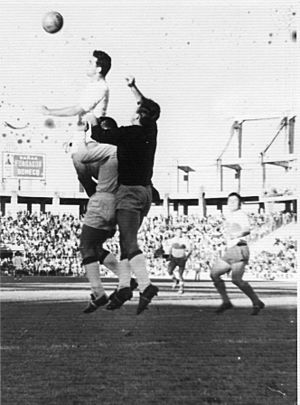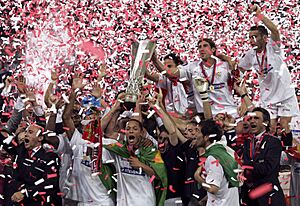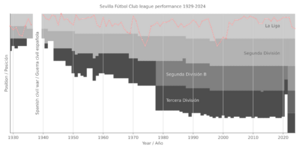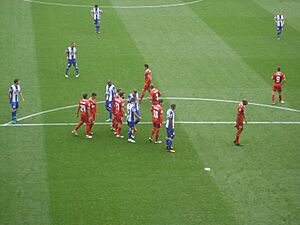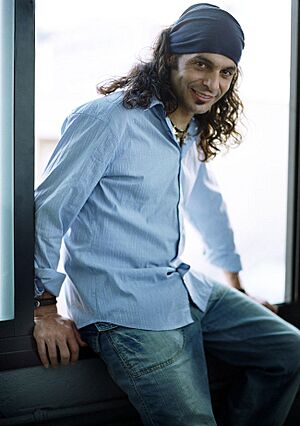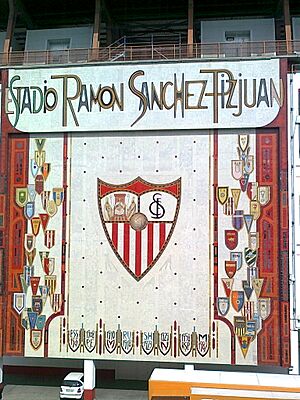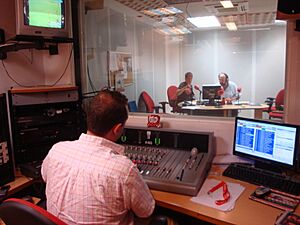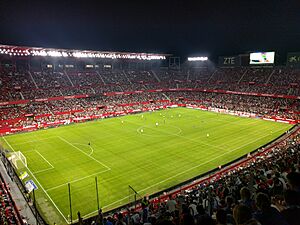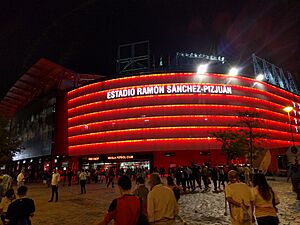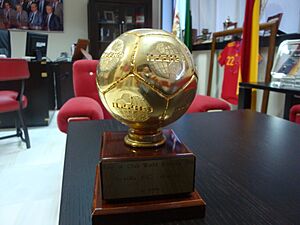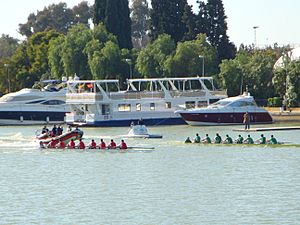Sevilla FC facts for kids
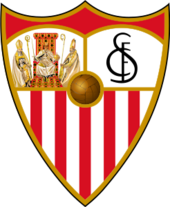 |
||||
| Full name | Sevilla Fútbol Club, S.A.D. | |||
|---|---|---|---|---|
| Nickname(s) | Los Nervionenses Los Hispalenses Palanganas Blanquirrojos Rojiblancos Sevillistas (supporters) |
|||
| Short name | Sevilla | |||
| Founded | 1890 as Sevilla Foot-ball Club |
|||
| Ground | Estadio Ramón Sánchez-Pizjuán | |||
| Capacity | 42,714 | |||
| Owner | Sevillistas de Nervión S. A. | |||
| President | José María del Nido Carrasco | |||
| Head coach | Matías Almeyda | |||
| League | La Liga | |||
| 2022–23 | La Liga, 12th of 20 | |||
|
||||
Sevilla Fútbol Club is a professional football club from Seville, Andalusia, in Spain. They play in La Liga, which is the top football league in Spain. The club started on January 25, 1890. This makes it Spain's oldest sports club focused only on football. Edward F. Johnston, who was born in Scotland, helped start Sevilla and became its first president.
Sevilla is the most successful football club in Andalusia when it comes to winning titles. They have won eighteen Andalusian Cups. They also won one La Liga title in 1945–46. The club has won five Spanish Cup titles and one Spanish Super Cup. Sevilla holds a record for winning the UEFA Cups / UEFA Europa Leagues seven times. They also won one UEFA Super Cup in 2006. The International Federation of Football History & Statistics named them the World's Best Club in 2006 and 2007. They were the first club to win this award two years in a row.
Sevilla's youth team, Sevilla Atlético, started in 1958. They currently play in Primera División RFEF. Sevilla FC also has a women's team. The club's home stadium is the Ramón Sánchez Pizjuán Stadium. It can hold 42,714 fans. The stadium is in the Nervión, Seville neighborhood. It is named after Ramón Sánchez-Pizjuán, who was president of Sevilla for 17 years. Sevilla has a big rivalry with their city rivals, Real Betis.
Contents
Club History
How Sevilla FC Started
Football came to Seville in the late 1800s. British people living in the city, many of whom owned businesses, brought the sport. Sevilla Fútbol Club was officially founded on January 25, 1890. It was first called Sevilla Foot-ball Club in English.
The club's founding document was published in a newspaper called the Dundee Courier on March 17, 1890. It explained how the club was formed. Young British and Spanish men decided to play football using Association Rules. They also chose to include "football" in the club's name. They elected their first leaders.
Here is a part of what the newspaper said:
Some six weeks ago a few enthusiastic young residents of British origin met in one of the cafés for the purpose of considering a proposal that we should start an Athletic Association, the want of exercise being greatly felt by the majority of us, who are chiefly engaged in mercantile pursuits. After a deal of talk and limited consumption of small beer, the "Club de Football de Sevilla" was duly formed and office-bearers elected. It was decided we should play Association rules (...) We were about half and half Spanish and British
The first president of Sevilla FC was Edward F. Johnston from Scotland. He was also the British vice-consul in Seville. Hugh MacColl, another Scot, was the first captain. Isaias White junior, who was MacColl's business partner, became the club's first secretary.
To celebrate the club's start, Isaias White invited Huelva Recreation Club to play a match in Seville. This game happened on March 8, 1890. It was the first official football match ever played in Spain. Sevilla FC won 2–0. A Sevilla player named Ritson scored the first goal in Spanish football history.
More football clubs were formed in Seville later, like Sevilla Balompíe in 1907 and Betis Football Club in 1909. But Sevilla FC, being the oldest, was the strongest team in the city during these early years.
In 1912, Sevilla FC won the first Copa de Sevilla. From 1915 to 1940, they played in the Campeonato Regional Sur (also known as the Copa Andalucía). Sevilla FC won 17 out of 20 of these championships.
In 1917, Sevilla FC played in the "Copa de España" for the first time. They were the first team from Andalusia to reach the final rounds of this competition. In 1928, when the "Campeonato Nacional de Liga" (National League Championships) started, Sevilla FC did not join the First Division right away. They lost a game that decided which teams would be in the new league.
At the end of the 1933–34 season, Sevilla FC moved up to the First Division. In 1935, they won their first "Campeón de Copa" (Cup Champions) title. They won it again in 1939 and 1948. Sevilla FC stayed in the First Division from 1933–34 until 1968. They have never dropped below the Second Division since then.
The 1945–46 season was very important for Sevilla. It was the first and only time they won the League championship. They also finished as "subcampeón de Liga" (League Runner-up) four other times.
Sevilla has played 78 times in the First Division and 13 times in the Second Division. They have also played in European tournaments like the "Copa de Europa" (European League Winners Cup) and the UEFA Cup many times. They also played in the UEFA Champions League in 2007–08.
More than 400 people play for Sevilla FC today. This includes two semi-professional teams and 12 youth teams.
Sevilla has always had international players. The first were Spencer and Herminio in the 1920s. Juan Arza, a player from the 1940s, was the top scorer in the Spanish League in 1954–55. About 30 Sevilla players have played for the Spain national football team.
Famous foreign players have also helped Sevilla FC. Diego Maradona, a world-famous Argentine player, played for the club in 1992–93. During that same season, Carlos Salvador Bilardo, a world champion coach, managed Sevilla FC.
Sevilla FC's stadium, the Ramón Sánchez Pizjuán, opened in 1958. It is one of the biggest stadiums in Spain. It even hosted a World Cup semi-final match in 1982. The stadium used to hold 75,000 fans. After its latest updates, it now has 45,000 seats.
Winning Trophies
Sevilla started winning national trophies after the Civil War. They won the 1945–46 La Liga title and two Copa del Rey titles. In the 1939–40 season, Sevilla won the cup by beating Racing de Ferrol 6–2. That same season, they almost won the Liga title but lost it on the last day. Sevilla's attacking players were known as los stukas and scored many goals.
In 1941, President Ramón Sánchez Pizjuán left the club to lead the Spanish Football Federation. Sevilla won its only Liga title in 1945–46, beating FC Barcelona by one point. Two years later, Sevilla won the 1948 Copa del Rey by beating Celta de Vigo 4–1.
A very important player signed during these years was the Spanish striker Juan Arza. Also, Campanal II, the nephew of player Campanal, made his debut as a defender. In the 1950–51 season, the team finished second in La Liga. Before the 1953–54 season, Argentine coach Helenio Herrera joined the club. Under him, the club finished high in the league standings several times.
In 1954, the club decided to build a new stadium. The old Nervión Stadium was too small. On October 28, 1956, President Sánchez Pizjuán suddenly passed away. To honor him, fans decided to name the new stadium after him. In the 1956–57 season, the team finished second in the Liga, which meant they qualified for the European Cup for the first time.
After the president's death, Ramón de Carranza became president. He promised to build the grand stadium Sánchez Pizjuán had dreamed of. The new Ramón Sánchez Pizjuán Stadium opened on September 7, 1958, with a friendly match. The first official game was on the opening day of the 1958–59 season, where Sevilla beat Real Betis 4–2.
Challenges and Stability
In the 1970s, Sevilla had to sell its best players to pay off debts from building the new stadium. They even sold some land next to the stadium. In the 1967–68 season, Sevilla went down to the Second Division for the first time in 31 years. But they came back up after just one season. The next season, Austrian coach Max Merkel, known as "Mr. Whip" for his strict training, helped the club finish third in the league.
However, the club was relegated again at the end of the 1972–73 season. In 1973, Sevilla signed their first black player, Biri Biri from Gambia. He became a very popular player, and a fan group is still named after him today. In the 1974–75 season, with Argentine coach Roque Olsen, the club returned to the First Division. In the late 1970s, Sevilla signed more Argentine players like Héctor Scotta and Daniel Bertoni.
The team played in the UEFA Cup for two seasons in a row from 1981 to 1983. In 1982, the World Cup was held in Spain. Sevilla's Ramón Sánchez Pizjuán stadium hosted a semi-final match. In the 1985–86 season, coach Manolo Cardo left after five years. Francisco played in the 1986 FIFA World Cup for Spain. Vicente Cantatore helped the club qualify for the UEFA Cup at the end of the 1989–90 season.
In the 1992–93 season, the famous Argentine player Diego Maradona joined Sevilla. However, his time at the club was not very successful due to injuries and disagreements with the coach. Later, Luis Aragonés became manager and helped the team qualify for the UEFA Cup in the 1994–95 season.
After the 1994–95 season, Sevilla was almost moved down from the top league for financial reasons. But fans protested, and Sevilla was allowed to stay in La Liga.
These events caused problems for the club, with many changes in presidents and managers. Sevilla was relegated at the end of the 1996–97 season but returned in 1999. In the early 2000s, Roberto Alés became president. The club was in a difficult situation. The team had dropped to the Second Division in 2000. Many players retired or were sold. The club hired a less known coach, Joaquín Caparrós. He helped the team win the Second Division in his first season.
Success in the 21st Century
In May 2002, José María del Nido became president. He kept Caparrós as coach and Monchi as sporting director.
On October 6, 2002, after some fans caused trouble, Sevilla had to play their next four home matches without any fans. This was the longest punishment ever given to a La Liga team. The club finished sixth in the 2003–04 La Liga, which meant they qualified for the 2004–05 UEFA Cup. This was their first time back in a European competition since 1995–96. In the 2004–05 league season, Sevilla finished sixth again and qualified for the 2005–06 UEFA Cup.
Sevilla won their first European trophy in the 2006 UEFA Cup Final on May 10, 2006. They beat English club Middlesbrough 4–0. This was under their new manager Juande Ramos. Luís Fabiano scored first, then Enzo Maresca scored twice, and Frédéric Kanouté scored the last goal. This was the club's first major title in 58 years, and it happened in their 100th anniversary season.
Sevilla started their 2006–07 season by winning the 2006 UEFA Super Cup on August 25, 2006. They beat Barcelona 3–0. The season ended with their second straight UEFA Cup win. This time, they beat fellow Spanish club Espanyol in a penalty shootout. Sevilla goalkeeper Andrés Palop saved three penalties.
On November 12, 2006, Sevilla played their 2,000th game in La Liga. Sevilla also won the 2007 Copa del Rey Final against Getafe. Kanouté scored the only goal. Sevilla finished third in La Liga that season. This qualified them for the 2007–08 Champions League, their first time in 50 years. Because of these wins, Sevilla was named the IFFHS Team of the Year for the second year in a row.
The season took a sad turn when defender Antonio Puerta had a heart attack and passed away on August 28. Three days later, Sevilla lost 3–1 to Milan in the 2007 UEFA Super Cup. Juande Ramos, the coach who led Sevilla to these successes, left the club. Sevilla Atlético manager Manolo Jiménez took over. Despite these challenges, Sevilla still did well in the Champions League.
In the summer of 2008, players like Dani Alves and Seydou Keita were sold to Barcelona. Sevilla finished third in La Liga, setting a club record for away victories.
The 2009–10 season saw them qualify for the Champions League for the third time in a row. On May 19, 2010, Sevilla beat Atlético Madrid 2–0 in the 2010 Copa del Rey Final. Goals came from Diego Capel and Jesús Navas.
The Unai Emery Years
In January 2013, Unai Emery became the new manager. The club was facing financial problems and had to sell star players like Álvaro Negredo and Jesús Navas. They brought in younger players like Carlos Bacca and Kevin Gameiro.
On May 14, 2014, Sevilla won their third Europa League title. They beat Benfica in a penalty shootout in the 2014 UEFA Europa League Final. After this, key midfielder Ivan Rakitić was sold. In summer 2015, top scorer Carlos Bacca also left. But the club brought in new players like Grzegorz Krychowiak and Éver Banega.
On May 27, 2015, Sevilla won the Europa League again. They beat Ukrainian club Dnipro Dnipropetrovsk 3–2 in the 2015 Final. This made them the only club to win the Europa League four times.
The club reached the Europa League final for a third time in a row in 2016. They played against Liverpool in the 2016 Final. Sevilla won 3–1, with goals from Kevin Gameiro and two from captain Coke. With this win, Sevilla set a new record, lifting the trophy five times in ten years.
After Unai Emery
After Emery left, Jorge Sampaoli became manager. The club invested a lot in new players. These included goalkeeper Salvatore Sirigu, playmaker Ganso, and forwards Luciano Vietto and Wissam Ben Yedder. Other new players were Franco Vázquez, Hiroshi Kiyotake, Pablo Sarabia, and Samir Nasri.
In December 2017, Vincenzo Montella became the new manager. In the 2017–18 UEFA Champions League season, Sevilla reached the knockout stages. They beat Manchester United in the Round of 16. This was their first time reaching the quarter-finals in 60 years. They eventually lost to Bayern Munich.
On June 4, 2019, Julen Lopetegui was announced as the new manager. On August 16, 2020, Sevilla beat Manchester United 2–1 in the semi-finals of the 2019–20 UEFA Europa League. They went on to win the trophy for a record sixth time, beating Inter Milan 3–2 in the final.
On May 31, 2023, Sevilla won their record-extending seventh Europa League title. They drew 1–1 with Roma after extra time and won 4–1 on penalties.
Club Leadership and Money
Presidents
Sevilla is run by a president and a board of directors. The board discusses and approves important decisions. The president also has a general director and a sports director to help.
Sevilla has had 28 presidents in its history. The first was Edward Farquharson Johnston from Scotland. Some of the longest-serving presidents include Ramón Sánchez Pizjuán and José María del Nido Benavente.
In 1992, Sevilla FC became a Sporting Limited Association. This meant that instead of members electing the president, shareholders now elect them based on how much of the club they own.
Ownership
- Sevillistas de Nervion S.A. (José María del Nido Carrasco, Roberto Alés, José Castro, José Martín Baena, Francisco Guijarro, and José Gómez Miñán)
- Rafael Carrión Moreno
- 777 Partners
- Accionistas Unidos (Supporters' Trust / Minor shareholders)
Club Symbols
Anthems
Sevilla has two official songs:
- Official Anthem of Sevilla FC: This song was created in 1983. Ángel Luis Osquiguilea de Roncales wrote the words, and Manuel Osquiguilea de Roncales composed the music.
- Centennial Anthem of Sevilla FC: The singer Javier Labandón, known as 'El Arrebato', wrote this song in 2005. It celebrated 100 years since the club was officially registered. It became the number one song in Spain and the best-selling football club anthem in Spanish history. In 2006, 'El Arrebato' received a golden record for his anthem.
Crest
When the team first started, they used a round crest. It had the club's name and founding date on the outside. Inside, the letters "SFC" were linked together, just like on the current crest. Juan Lafita, who was close to the club, designed this first crest.
The second crest was designed in 1922 by Pablo Rodríguez Blanco. He divided the shield into three parts that look like a heart. The three figures on it are Christian saints from the city's coat of arms: Isidore of Seville, Ferdinand III of Castile, and Leander of Seville. On the right side are the letters "SFC."
Where the three parts meet, there is an old football. The red and white stripes are thought to come from the club's wish to have red and white as their official colors from the beginning. Another idea is that the bottom part is inspired by the flag King Ferdinand III of Castile carried when he took back Seville in 1248.
Flag
Sevilla's flag is described in the club's rules from 1982. It is a rectangle divided by a diagonal line. This line goes from the bottom left corner to the top right corner. It creates two triangles: the top one is white, and the bottom one is red.
Kit
Sevilla first wore shirts with a sponsor logo in the 1986–87 season. It promoted the Seville Expo '92. Before that, in 1980–81, the club signed its first deal with a kit manufacturer, the German company Adidas. Since 2022, the kits have been made by Castore.
|
|
Media
Sevilla has its own media. SFC Radio started in September 2004 and broadcasts all day. Its TV channel, SFC TV, first aired in 2005–06. Since June 8, 2009, the TV coverage has been on the club's website. Sevilla also publishes a newspaper after every match and a magazine before home games.
Players
Current Squad
|
|
Reserve Squad
Players on Loan
|
Current Coaching Staff
| Position | Name |
|---|---|
| Head coach | |
| Assistant coach | |
| Technical assistant | |
| Fitness coach | |
| Physiotherapist | |
| Analyst | |
| Goalkeeping coach |
Facilities
Stadium
Before building the Ramón Sánchez Pizjuán Stadium, Sevilla played in different places around Seville. These included la Trinidad Field and 'La Victoria' Stadium.
The Ramón Sánchez Pizjuán Stadium was planned in 1937. Construction started in 1954. Manuel Muñoz Monasterio, who also designed Real Madrid's stadium, created its design.
The stadium was finished in the summer of 1958. It opened on September 7, 1958, with a friendly match. The east and west stands were completed in 1974. This increased the stadium's capacity to 70,000. For the 1982 World Cup, the capacity was reduced to 66,000. New lights, a roof, and a mosaic on the main wall were added. The stadium hosted two World Cup games, including a semi-final.
The 1986 European Cup Final was also held here. The stadium's capacity was later reduced to 42,714 seats. This was done to follow new FIFA rules that required all standing areas to be converted to seats.
The Spain national team has played 26 matches in the stadium since 1961. They have not lost any of these games. In 2005, a mosaic showing Seville's history was built above the southern gate to celebrate the club's 100th anniversary. The stadium now has the club's media offices, a store, a museum, and a trophy room.
Training Facilities
The club's training facilities are called La Ciudad Deportiva (The Sporting City). The first team uses them for practice. The reserve teams and women's team play their matches there. These facilities opened in 1974 and are located outside the city. They have four natural grass fields and three artificial fields. There is also an artificial field for the Antonio Puerta Football School. The facilities include changing rooms, a gym, a press room, a cafeteria, and a medical center.
League Performance Over the Years
|
|
|
|
|
- 82 seasons in La Liga
- 13 seasons in Segunda División
Sevilla has played almost all its seasons in the first division since joining La Liga in 1934–35. They won La Liga in 1945–46 and finished second four times. The club has only dropped to the Segunda División a few times, winning the second division title in 1968–69 and 2000–01.
European Competitions
Sevilla first played in European competitions in the 1957–58 season. They played in the European Cup because Real Madrid had already qualified by winning the cup the season before.
- Information is correct as of December 12, 2023
| Competition | Pld | W | D | L | GF | GA | GD |
|---|---|---|---|---|---|---|---|
| European Cup / UEFA Champions League | 78 | 30 | 21 | 27 | 117 | 115 | +2 |
| UEFA Cup / UEFA Europa League | 158 | 92 | 33 | 33 | 283 | 133 | +150 |
| UEFA Super Cup | 7 | 1 | 1 | 5 | 12 | 17 | −5 |
| UEFA Cup Winners' Cup | 2 | 1 | 0 | 1 | 2 | 4 | −2 |
| Inter-Cities Fairs Cup | 4 | 1 | 1 | 2 | 4 | 7 | −3 |
| Total | 249 | 125 | 56 | 68 | 418 | 276 | +142 |
Pld = Matches played; W = Won; D = Drawn; L = Lost; GF = Goals for; GA = Goals against; GD = Goal difference
Club Achievements
Sevilla has won many trophies at regional, national, and European levels. They hold a record for winning the UEFA Cup / UEFA Europa League seven times. They are the most successful club in Andalusia. In 2010, Sevilla was given permanent possession of the Copa del Rey trophy. This was to celebrate Spain winning the 2010 FIFA World Cup.
| Type | Competition | Titles | Seasons |
|---|---|---|---|
| Domestic | La Liga | 1 |
1945–46 |
| Segunda División | 4 |
1929, 1933–34, 1968–69, 2000–01 |
|
| Copa del Rey | 5 |
1935, 1939, 1947–48, 2006–07, 2009–10 |
|
| Supercopa de España | 1 | 2007 | |
| Continental | UEFA Cup/UEFA Europa League | 7 |
2005–06, 2006–07, 2013–14, 2014–15, 2015–16, 2019–20, 2022–23 |
| UEFA Super Cup | 1 | 2006 | |
| Intercontinental | |||
| UEFA-CONMEBOL Club Challenge | 1 | 2023 | |
| Regional | Campeonato Regional Sur | 17 |
1916–17, 1918–19, 1919–20, 1920–21, 1921–22, 1922–23, 1923–24, 1924–25, 1925–26, 1926–27, 1928–29, 1929–30, 1930–31, 1931–32, 1935–36, 1938–39, 1939–40 |
- record
- s shared record
Friendly Tournament Wins
- Antonio Puerta Trophy
- Winners (11): 2008, 2009, 2011, 2012, 2013, 2014, 2017, 2019, 2022, 2023, 2024
- Ramón de Carranza Trophy
- Winners (6): 1955, 1956, 1957, 2004, 2008, 2009
- Costa del Sol Trophy
- Winners (2): 1964, 2004
- Achille & Cesare Bortolotti Trophy
- Winners (1): 2010
- Ciudad de la Línea Trophy
- Winners (3): 2001, 2002, 2003
- Teresa Herrera Trophy
- Winners (4): 1946, 1954, 1960, 2011
- Colombino Trophy
- Winners (4): 1975, 1985, 1996, 2005
- City of Seville Trophy
- Winners (7): 1972, 1973, 1976, 1978, 1982, 1984, 1994
- Russian Railways Cup
- Winners (1): 2008
- Trofeo de la Sal
- Winners (1): 2010
- Antonio Camacho Memorial
- Winners (1): 2012
- Costa Brava Trophy
- Winners (1): 2012
- Supercopa Euroamericana
- Winners (1): 2016
Other Awards and Records
- Medal of Andalusia (2005), given by the Junta de Andalucía.
- Best club team in the world in 2006 and 2007 by the International Federation of Football History & Statistics (IFFHS).
- Best team of 2006 as voted by the Federation of Sports Journalists of Andalucía.
- Prize for the best team of 2006 from the Spanish Sports Press Association.
- In January 2007, Sevilla received the 15th Communication Award from the Seville Press Association.
- Royal Order of Sports Merit, given by the Superior Council of Sports.
- Gold medal from the Royal Chamber of Commerce for good financial management.
- The only team to win the UEFA Europa League three times in a row: 2013–14, 2014–15, 2015–16.
Individual Player Awards
- Pichichi Trophy (1):
- Zarra Trophy (2):
- Zamora Trophy (1):
 Yassine Bounou (2022)
Yassine Bounou (2022)
Team Records
As of the 2020–21 season.
General Information
| Concept | Times |
|---|---|
| Seasons in La Liga | 77 |
| Seasons in Segunda División | 13 |
| Promotions to La Liga | 5 |
| Participations in the Copa del Rey | 89 |
| Participations in UEFA competitions | 24 |
| All-time position in La Liga | 6th |
| Number of international players contributed to the Spain national team | 37 |
Updated March 31, 2020
Most Goals Scored in a League Match
| Match | Result | Season |
|---|---|---|
| Sevilla – Barcelona | 11–1 | 1940–41 |
| Sevilla – Valencia | 10–3 | 1940–41 |
| Sevilla – Oviedo | 10–0 | 1941–42 |
| Celta Vigo – Sevilla | 1–5 | 1943–44 |
| Las Palmas – Sevilla | 2–5 | 1985–86 |
| Sevilla – Sporting Gijón | 5–1 | 1994–95 |
| Sevilla – Hércules | 5–0 | 1996–97 |
| Sevilla – Racing Santander | 5–2 | 2003–04 |
| Sevilla – Zaragoza | 5–0 | 2007–08 |
| Racing Santander – Sevilla | 1–5 | 2009–10 |
| Sevilla – Rayo Vallecano | 5–2 | 2011–12 |
| Sevilla – Real Betis | 5–1 | 2012–13 |
| Sevilla – Granada | 5–1 | 2014–15 |
| Sevilla – Getafe | 5–0 | 2015–16 |
| Sevilla – Espanyol | 6–4 | 2016–17 |
| Sevilla – Osasuna | 5–0 | 2016–17 |
| Levante – Sevilla | 2–6 | 2018–19 |
| Sevilla – Levante | 5–0 | 2018–19 |
| Sevilla – Real Sociedad | 5–2 | 2018–19 |
| Sevilla – Rayo Vallecano | 5–0 | 2018–19 |
| Sevilla – Levante | 5–3 | 2021–22 |
| Sevilla – Almería | 5–1 | 2023–24 |
Most Goals Conceded in a League Match
| Match | Result | Season |
|---|---|---|
| Sevilla – Oviedo | 0–5 | 1942–43 |
| Sevilla – Real Madrid | 0–5 | 1962–63 |
| Valencia – Sevilla | 8–0 | 1943–44 |
| Real Madrid – Sevilla | 8–0 | 1958–59 |
| Espanyol – Sevilla | 5–1 | 1986–87 |
| Zaragoza – Sevilla | 8–1 | 1987–88 |
| Real Madrid – Sevilla | 5–2 | 1989–90 |
| Real Madrid – Sevilla | 7–0 | 1990–91 |
| Real Madrid – Sevilla | 5–0 | 1992–93 |
| Barcelona – Sevilla | 5–2 | 1993–94 |
| Deportivo La Coruña – Sevilla | 5–1 | 1994–95 |
| Deportivo La Coruña – Sevilla | 5–2 | 1999–2000 |
| Real Madrid – Sevilla | 5–1 | 2003–04 |
| Espanyol – Sevilla | 5–0 | 2005–06 |
| Barcelona – Sevilla | 5–0 | 2010–11 |
| Getafe – Sevilla | 5–1 | 2011–12 |
| Sevilla – Real Madrid | 2–6 | 2010–11 |
| Sevilla – Real Madrid | 2–6 | 2011–12 |
| Real Madrid – Sevilla | 7–3 | 2013–14 |
| Barcelona – Sevilla | 5–1 | 2014–15 |
| Real Madrid – Sevilla | 5–0 | 2017–18 |
| Eibar – Sevilla | 5–1 | 2017–18 |
| Sevilla – Betis | 3–5 | 2017–18 |
| Sevilla – Atlético Madrid | 2–5 | 2017–18 |
| Atlético Madrid – Sevilla | 6–1 | 2022–23 |
| Barcelona – Sevilla | 5–1 | 2024–25 |
Player Records
Top Scorers in Club History
| Rank | Player | Goals |
|---|---|---|
| 1 | 226* | |
| 2 | 206 | |
| 3 | 159 | |
| 4 | 136 | |
| 5 | 107 | |
| 6 | 90 | |
| 7 | 85 | |
| 8 | 83 | |
| 9 | 77 | |
| 10 | 73 |
(*) 43 goals from the Campeonato Regional Sur are not counted as it was not an official tournament.
Most Official Appearances
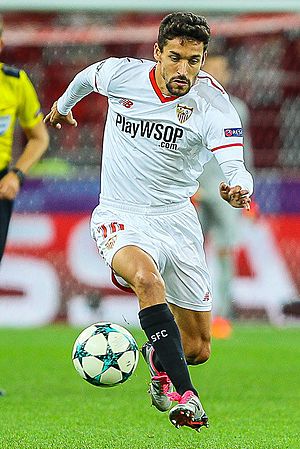
| Rank | Player | Apps |
|---|---|---|
| 1 | 705 | |
| 2 | 415 | |
| 3 | 414 | |
| 4 | 413 | |
| 5 | 403 | |
| 6 | 401 | |
| 7 | 386 | |
| 8 | 372 | |
| 9 | 370 | |
| 10 | 334 |
Other Sevilla Teams
Sevilla has other teams besides the main one. Their B team, Sevilla Atlético, started in 1958. It plays in the second tier of Spanish football. Famous players like Sergio Ramos and Jesús Navas came from this team. They both played for Spain when it won the 2010 World Cup. Sevilla FC C, founded in 2003, plays in the fourth tier.
Sevilla's women's team plays in the top Spanish women's football league. They play their home games at the club's training ground. Sevilla took over the women's club in 2004. Their best season was 2005–06, when they finished second in the league and the national cup.
Since 2007–08, a Sevilla veterans' team has played in the Spanish indoor football league. Sevilla FC Puerto Rico is a football club in Puerto Rico that is linked to Sevilla. They share a similar badge and kit. Sevilla has also been part of Superleague Formula since 2008. This is a racing series where cars represent football clubs.
The Sevilla-Betis regatta is a yearly rowing competition. It takes place on Seville's Guadalquivir river. Different boat categories represent Sevilla and its rival Real Betis. Sevilla has won 30 out of 47 regattas.
Fans and Rivalries
Fans
Sevilla FC is now a Sporting Limited Association. This means that only shareholders can make decisions for the club. Minority shareholders have a group that represents them at the club's yearly meetings.
People who are called "members" are actually fans who buy a season ticket each year. This ticket lets them attend all home matches. These members sometimes get special benefits.
Fan Clubs
Sevilla's fan clubs are mostly in the city of Seville, its province, and the rest of Andalusia. There are also fan clubs in other parts of Spain. Most of them are part of the "San Fernando Fan Clubs Federation." This group is independent from the club's main board.
Ultras
The Biris Norte is a group of dedicated supporters called ultra fans. They sit in the North grandstand of the Ramón Sánchez Pizjuán stadium. The group is named after the Gambian player Alhaji Momodo Njie, known as Biri Biri. He was very popular with Sevilla fans in the 1970s. The "Biris Norte" started in 1974–75 and is one of the oldest ultra fan groups in Spain.
Rivalries
Sevilla has a big rivalry with their city rivals, Real Betis. This is called the Seville derby. They first played each other on October 8, 1915. Sevilla won that match 4–3. This game is one of the most important derbies in Spanish football. Sevilla also has rivalries with Atlético Madrid and Valencia CF.
See also
 In Spanish: Sevilla Fútbol Club para niños
In Spanish: Sevilla Fútbol Club para niños


